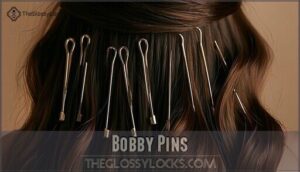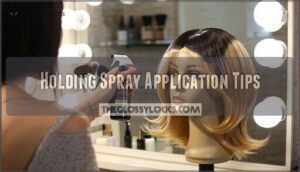This site is supported by our readers. We may earn a commission, at no cost to you, if you purchase through links.
 If you’re wondering, "what can I use instead of wig glue," there are several great options to keep your wig secure.
If you’re wondering, "what can I use instead of wig glue," there are several great options to keep your wig secure.
Try holding spray for a quick, mess-free hold or a wig grip band, which is comfortable and keeps things snug without slipping.
Elastic bands work too, especially if your wig already has loops for them.
Wig clips, sewn into the cap, are another reliable choice, and even trusty bobby pins can do the trick if you’re in a pinch.
Each method is safe and avoids the irritation some people experience with glue, making them a good alternative to consider, and if you’re curious about which option might suit you best, Keep reading!
Table Of Contents
- Key Takeaways
- Holding Spray
- Wig Clips
- Elastic Band
- Wig Grips
- Bobby Pins
- Securing a Wig With Holding Spray
- Using Hair Gel for Wig Installation
- Applying a Wig With a Wig Grip
- Frequently Asked Questions (FAQs)
- What type of wig glue do you use?
- What is substitute for egg whites?
- What can I use instead of wig glue?
- How to remove lace wig glue?
- Do you need lace glue for a wig?
- How do you glue a wig?
- What to use if you don’t have wig glue?
- What can be used as hair glue?
- What are the benefits of wig tape?
- How does a wig headband work?
- Conclusion
Key Takeaways
- You can use wig grips or elastic bands for a secure, adhesive-free fit that protects your hairline.
- Bobby pins and wig clips are quick, affordable alternatives that work well for temporary wear.
- Holding spray and hair gel provide strong, flexible holds without the mess of glue, but might require reapplication.
- Choose a method based on your needs for comfort, durability, and ease of use.
Holding Spray
You’ll find that holding spray offers a gentler alternative to wig glue while still providing a secure fit for your favorite wigs.
Holding spray delivers a secure, long-lasting fit, protecting your hairline while offering a gentle, comfortable alternative to traditional wig adhesives.
It creates a long-lasting bond between the lace and your skin without the harsh chemicals that can damage your hairline over time.
Pros of Holding Spray
Holding spray frequently offers impressive benefits when you’re seeking a wig glue alternative that won’t compromise your comfort or style.
- Long-lasting hold: Holding spray creates a secure attachment that keeps your wig in place throughout the day, even during moderate physical activity.
- Gentle hairline protection: Unlike harsh adhesives, quality holding spray for wigs won’t damage your natural hairline or cause irritation to sensitive skin.
- Easy application: Simply spray around the perimeter of your wig, press down, and you’re set—much less messy than dealing with sticky glue residue.
The spray’s lightweight formula allows your scalp to breathe while maintaining a strong bond. Many varieties offer sweat resistance to prevent slipping during warmer weather.
You can find various holding spray options online. When paired with a wig grip or wig clips, holding spray provides double security without the hassle of tape adhesive.
Cons of Holding Spray
While offering a quick fix for your wig needs, holding spray comes with notable drawbacks.
The alcohol content can cause scalp irritation for sensitive skin types. Residue buildup happens faster than with other wig glue alternatives, requiring more frequent cleaning.
Many users report disappointment with the hold duration, especially in humid or active situations. Product limitations become apparent when you need multi-day wear.
Unlike stronger wig adhesive alternatives, holding spray might need reapplication throughout the day. For those seeking a wig glue substitute with maximum staying power, you’ll want to keep these constraints in mind.
Some users also report dealing with specific holding spray drawbacks.
Wig Clips
You’ll find that wig clips offer a quick and secure way to attach your wig without the mess of adhesives.
These small, comb-like attachments sewn into your wig cap simply slide into your natural hair to keep everything firmly in place, using a method that is secure.
Advantages of Wig Clips
Wig clips provide a practical solution for those seeking a break from sticky wig glues. While holding sprays require careful application, wig clips offer straightforward secure attachment without any messy adhesives.
These small but mighty accessories transform how you wear your wigs with several key benefits:
- Secure attachment – Clips grip your natural hair firmly, keeping your wig in place throughout the day
- Easy adjustments – You can reposition as needed without damaging your hair or scalp
- Gentle option – No harsh chemicals means healthier skin and natural hair underneath
- Reusable clips – Unlike adhesives, these nonadhesive methods can be used repeatedly
- Beginner friendly – Perfect for those new to wigs who want simple wig security
Wig clips for security work particularly well if you have enough natural hair for the clips to grab onto. They’re also ideal for temporary wear situations when you don’t want the commitment of adhesives. Those with thinner hair may find that lightweight clips are essential for avoiding damage. With wig clips, you’ll enjoy freedom of movement while maintaining confidence in your look.
Limitations of Wig Clips
Despite their popularity, wig clips come with several drawbacks you should consider.
The most noticeable limitation is clip visibility, which can show through finer hair textures.
Hold strength is another concern – clips may not provide enough security during active movements or windy days.
These nonadhesive methods can also cause hair damage if placed in the same spots repeatedly.
Bulkiness issues are common, as clips add extra thickness that might create bumps under your wig.
Limited styles become a reality too, as clips restrict how you can wear your hair underneath.
One should consider reducing clip visibility for a seamless look.
While wig clips for security are effective for many, they’re not ideal for all head shapes or sizes.
If you have a particularly small or large head, finding alternative wig attachment options that fit properly might be challenging.
Elastic Band
You’ll find elastic bands offer a secure way to wear your wig without any glue or adhesive.
They’re sewn directly into the wig cap to create a snug fit that keeps your wig in place all day.
Benefits of Elastic Band
Elastic bands offer a customizable fit that makes them a standout among glueless wig options.
You’ll appreciate how beginner-friendly they’re to install—simply measure, sew, and secure.
The gentle hairline protection they provide is unmatched, as they distribute pressure evenly without harsh adhesives.
Your natural hair stays protected while enjoying cost-effective security that doesn’t require constant replacement.
Many users find this alternative wig attachment particularly comfortable for all-day wear.
This is especially helpful if you’re experiencing hair elasticity issues and need a break from harsh chemicals.
The elastic band method creates a snug, reliable fit that moves with you, making it perfect for active lifestyles without the worry of shifting or slipping.
Drawbacks of Elastic Band
While elastic bands offer security, they come with notable drawbacks.
- Lace flatness suffers as bands may create bumps under your wig
- Tension issues can cause headaches after extended wear
- Band slippage occurs when not properly secured
- Sewing difficulty presents challenges for beginners
You’ll also find elastic longevity isn’t great – bands stretch out over time, requiring replacement. Some users report discomfort when the wig comfort band feels too tight against their hairline.
For sensitive scalps, a wig grip band might be a better wig glue alternative. Despite these challenges, many still prefer elastic bands over adhesives for their natural look and temporary nature.
Wig Grips
You’ll love wig grips as a simple, adhesive-free way to keep your wig in place all day long.
These velvet-lined headbands create friction against your scalp or natural hair, preventing slipping without any sticky residues or potential skin irritation.
Pros of Wig Grips
In the context of securing your wig, wig grips offer a treasure trove of benefits that make them a standout alternative to traditional glue.
These velvet-lined bands create a secure fit while keeping your natural hair and sensitive scalp protected.
Wig grips shine in three key areas:
Exceptional protection, reusable convenience, and all-day comfort make wig grips a trusted choice for secure, adhesive-free wig wearing.
- They provide exceptional hairline protection, preventing the friction and damage often caused by adhesives
- Their reusable option saves you money over time, unlike one-time-use adhesives
- The comfortable wear allows for all-day use without the tight, pulling sensation of other methods
The easy application of a wig grip band means you can secure your wig without glue in minutes.
Simply place the band around your head, adjust for comfort, and position your wig on top.
The velvet material creates natural friction that holds everything in place.
Many users appreciate that wig grips work well with various wig types and styles while providing consistent, reliable security.
Cons of Wig Grips
Wig grips come with several downsides you should consider. They can cause overheating scalp in warm weather and the grip bulkiness might feel uncomfortable during all-day wear.
Grip slippage is another common issue, especially with synthetic hair wigs. You’ll face cleaning difficulty as these bands require regular washing to prevent buildup.
Many users report grip discomfort when worn for extended periods. If you have wig adhesive sensitivity, a wig grip band might seem like a perfect solution, but the pressure around your hairline can sometimes cause irritation.
For maximum wig comfort, consider rotating between different wig glue alternatives.
Bobby Pins
You’ll find bobby pins are a simple yet effective way to secure your wig without dealing with messy adhesives.
They’re an inexpensive option that you can easily place around your hairline for quick fixes when you’re in a hurry, which makes them a great solution for quick adjustments.
Advantages of Bobby Pins
In the context of glue-free wig options, bobby pins stand out as tiny heroes for your wig security needs.
These simple tools offer remarkable advantages for anyone seeking secure wig methods without adhesives.
- Affordability: Bobby pins cost just pennies compared to specialized wig products, making them the most budget-friendly alternative.
- Accessibility: Available at any drugstore or supermarket, you’ll never be caught without this wig securing option.
- Quick fixes: Perfect for emergencies, bobby pins can be inserted in seconds to stop a shifting wig.
- Customization: Place them strategically around your hairline or at tension points for personalized security.
- Simplicity: No special skills needed—just slide them through your natural hair and wig cap for instant stability.
Bobby pins work best when placed at the temples, nape, and crown areas.
The small metal clips grip both your natural hair and the wig’s wefts, creating a secure hold without damaging either.
For those seeking to style their wigs, consider the versatility of ceramic flat irons.
For maximum effectiveness, cross two pins in an X-pattern at key pressure points.
Disadvantages of Bobby Pins
Bobby pins might seem like a simple fix, but they come with some downsides.
For starters, they can cause scalp irritation if placed too tightly, leading to discomfort over time.
Hair damage is another risk, as pins can tug on your natural strands, potentially leading to hairline damage.
Their limited security means they might fail to keep your wig in place during long or active days, and visible pins can be a giveaway, compromising a seamless look.
Additionally, application difficulty can frustrate beginners, especially when trying to secure a full wig.
While bobby pins are handy, exploring other wig securing methods or wig alternatives can offer more reliable solutions without these issues, providing a better approach to achieve a seamless look.
Securing a Wig With Holding Spray
Holding spray is a simple and effective way to secure your wig without using glue.
It provides a firm hold while being gentle on your hairline, making it a safer option for regular use.
Steps for Using Holding Spray
To secure your wig with holding spray, follow these steps for a firm, natural fit:
- Clean your hairline to remove oils and prevent product residue buildup.
- Section the hair for even spray application.
- Spray your hairline lightly with holding spray designed for wigs, like g?t2b Freeze Spray.
- Let it dry fully or use a blow dryer for faster spray hold time.
- Repeat if extra adhesive strength is needed.
- Press the lace gently into place.
- Wrap with a silk scarf for about 10 minutes to avoid hairline damage.
Holding Spray Application Tips
A flawless wig application needs the right balance of technique and spray hold strength.
To prevent sticky residue while accounting for skin sensitivity, hold the spray 6-8 inches away.
Use light, even mists instead of heavy coats.
Let it dry completely before styling to avoid clumping.
| Concern | Tip |
|---|---|
| Spray hold strength | Apply light layers for flexibility. |
| Alcohol content concerns | Choose low-alcohol sprays. |
| Application frequency | Reapply lightly, only as needed. |
| Residue removal | Cleanse daily to protect skin. |
Following these wig application tips guarantees secure, comfortable wear, and helps prevent issues like sticky residue and skin irritation, ensuring a comfortable experience.
Using Hair Gel for Wig Installation
Hair gel can be a simple and effective way to secure your wig without glue.
It provides a firm hold while being gentle on your edges and easy to wash out.
How to Apply a Wig With Hair Gel
If you’re looking for a no-glue wig install, hair gel is a quick and reliable option.
Choose a stronghold gel like got2b Glued. Apply a thin layer along your hairline, press the wig lace gently, and let it dry completely.
Styling after gel application is hassle-free, and the method protects your hairline compared to harsh adhesives.
For best results, consider using a curl cream beforehand to moisturize, which can enhance the overall curl definition.
To avoid gel residue, use shampoo or apple cider vinegar for removal.
This approach offers secure, temporary hold without compromising comfort or causing damage.
Hair Gel for Wigs: Pros and Cons
Hair gel offers a quick, adhesive-free option for securing wigs, but it’s not without considerations.
It provides a reliable hold, making it handy for daily use. However, gel residue can build up, affecting wig styling products and the wig’s base.
Overusing adhesive methods like hair gel might strain your hairline, risking damage. To protect hairline safety, use proper application techniques and gentle gel alternatives.
Always check gel ingredients to verify they suit your scalp, preventing irritation or clogged pores, and ensuring the use of gentle gel.
Applying a Wig With a Wig Grip
A wig grip is an easy-to-use alternative that keeps your wig securely in place without adhesives.
It’s a soft, adjustable headband that prevents slipping while being gentle on your scalp.
Steps for Wig Grip Application
To use a wig grip band effectively, follow these simple steps:
- Grip Placement: Position the band around your head with the velvet side facing outward.
- Secure Velcro: Fasten the velcro for a snug but comfortable fit.
- Wig Positioning: Pull your wig over the band while keeping it centered.
- Adjust Comfort: Align the band to avoid tightness or slippage.
- Styling Tips: Style your wig as desired without tugging on the grip.
- Wig Grip Application: Check security before heading out.
This glue-free wig option guarantees safe and stable wig securing techniques.
Wig Grip Usage: Advantages and Disadvantages
Wig grips are a comfortable, glue-free wig option offering secure wear and protection for natural hair.
They’re breathable, widely available, and affordable, making them a favorite among wig securing methods.
However, wig grip usage isn’t perfect. They may feel bulky, lack adhesive-level security, or require adjustments for proper fit.
Finding a wig grip band that balances snugness and comfort is key. Also, heavy wigs or an active lifestyle might need extra support.
With care, wig grips provide a practical solution for many wig wearers.
-
Advantages of Wig Grips:
- Comfortable and gentle on the scalp
- Allows airflow for grip breathability
- Simple to use for all experience levels
- Easily hidden under wigs for a seamless look
- Protects hairline from tension or damage
- Affordable compared to adhesives
- Limits slipping and shifting
- Reusable, increasing grip lifespan
Frequently Asked Questions (FAQs)
What type of wig glue do you use?
You know what they say, ‘There’s more than one way to skin a cat.’
In the context of wig glue, some prefer holding sprays, wig grips, or elastic bands for secure and safe alternatives.
What is substitute for egg whites?
You can swap egg whites with aquafaba (the liquid from canned chickpeas), a flaxseed-water mix, or chia seeds soaked in water.
Each works well as a binder, depending on your recipe.
What can I use instead of wig glue?
Imagine skipping the sticky mess altogether.
Try wig grips or elastic bands—they’re simple, secure, and kind to your scalp.
Bobby pins or wig clips work too, offering comfort and freedom without harsh glues.
How to remove lace wig glue?
To remove lace wig glue, gently apply an oil-based remover or alcohol along the hairline.
Let it sit for a minute, then slowly peel the lace back while massaging more remover to dissolve residue.
Do you need lace glue for a wig?
You don’t always need lace glue for a wig.
Alternatives like wig grips, elastic bands, or bobby pins can secure your wig effectively while being gentler on your hairline and easier to apply.
How do you glue a wig?
Think of gluing a wig like creating a strong bridge—clean your hairline.
Apply thin layers of glue or gel, position the wig.
Press it firmly, and secure with a scarf for a smooth finish.
What to use if you don’t have wig glue?
You can secure your wig without glue using alternatives like wig grips, elastic bands, holding spray, wig clips, or bobby pins.
These options provide a secure hold, protect your hairline, and avoid sticky residues.
What can be used as hair glue?
When you’re in a pinch, holding spray, wig tape, or even gel can work as hair glue alternatives.
They offer secure holds without the mess, keeping your style intact while protecting your hairline.
What are the benefits of wig tape?
Wig tape gives you a strong, secure hold that can last all day.
It’s easy to use, gentle on your skin, and mess-free, making it a great option for worry-free wig wear.
How does a wig headband work?
A wig headband is like a trusty seatbelt for your wig.
You wear it under the wig, and its non-slip material grips snugly, preventing slippage.
It’s comfortable, breathable, and keeps your wig secure effortlessly.
Conclusion
According to surveys, over 60% of wig wearers seek alternatives to glue due to skin irritation.
If you’re asking, “What can I use instead of wig glue,” rest assured there are plenty of effective options.
From holding sprays and wig clips to elastic bands and wig grips, each method offers unique benefits.
Finding the right solution depends on your needs—comfort, ease, or durability.
Experiment with these choices to enjoy a secure fit without relying on glue.













